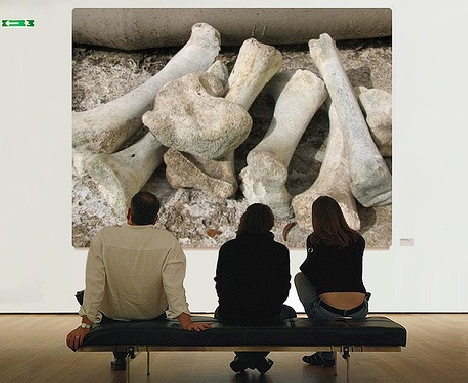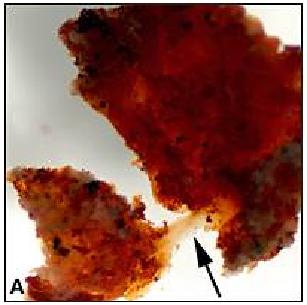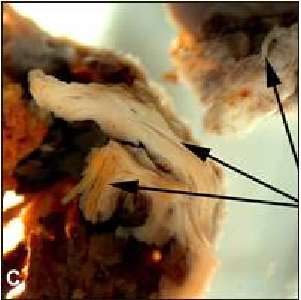Dinosaur Bones - a Whole Lot of Twistin' Goin' On

Dem bones, dem bones, dem dry bones!
What tune comes to mind when you think about dinosaur bones? Perhaps it is that old Gospel song, “Dem Bones, Dem Bones, Dem Dry Bones.” Paleontologists have long recognized that buried bones gradually lose their soft tissue 1 and “mineralize” into fossils, taking on the characteristics of the dirt around them. In the words of Genesis 3:19, “from dust you are and to dust you will return.” Yet over the past two decades, and as recently as May, 2009, 2 scientists have been reporting in respected, peer-reviewed journals that dinosaur bones can retain their soft tissue for 65-120 million years. In fact, these old dinosaur bones have been reported to smell like “cadavers,” 3 retain their “flexibility, elasticity and resilience,” 4 and contain “round microstructures” that are not called red blood cells only due to an “abundance of scientific caution.” 5 Creationists claim that these twistable, squishable bones can not be millions of years old. 6 7 ,8 ,9 ,10 Evolutionists that have made these finds claim that Creationists are twisting their words. 11 Creationists believe that Christians who try to make the Bible accommodate the millions of years necessary for evolution are twisting God’s words. In the words of Jerry Lee Lewis, there seems to be “a whole lotta twistin’ goin’ on” relative to these new dinosaur findings. Let’s investigate these recent discoveries in light of the creation versus evolution debate.
Twisted Bones
Creationists have reported on documented finds of fresh unfossilized dinosaur bones as far back as 1992. 12 Conventional wisdom at that time was that rock-hard fossils tens of millions of years old do not retain soft tissue, and, according to dinosaur paleontologist Thomas Holtz Jr. of the University of Maryland, paleontologists “don’t go to all this effort to dig this stuff out of the ground to then destroy it in acid [to test for soft tissue].” 11 However, while studying as a graduate student under ‘Dinosaur Jack’ Horner (upon whom Sam Neill’s lead character in the Jurassic Park movies was modeled) at Montana State University, Mary Schweitzer noticed that a dinosaur bone from a Montana dig site called Hell Creek exuded a distinctly organic odor, “like one of the cadavers we had in the lab who had been treated with chemotherapy before he died,” and when she approached Dr. Horner about it he said, “Oh, yeah, all Hell Creek bones smell.” 3 Thus, a relative novice in the field of paleontology noticed something that did not even register with old-line paleontologists and became one of the first scientists to use the tools of modern cell biology to study dinosaurs. On July 11, 1993, the NBC Today Show aired a video news report titled “Real “Jurassic Park”? Paleontologists See Red Blood Cells in a T-Rex Bone.” 13 The report contains an interview with Schweitzer, now a professor at North Carolina State University, in which she expressed excitement over a slice of T-rex thigh bone. “I looked through the microscope, and I saw the vessel channel with the structures in it, and I—I mean, I took one look, and I literally got goose bumps. It was just—I kept thinking, `It can’t be what it—it can’t be what it looks like.’“ Her paleontologist mentor at the time, Jack Horner, recalls that “They looked like red blood cells. And I told her, `Prove to me they’re not.’“ After many years of testing, they have not proven that these “round microstructures” from a T-Rex alleged to be 65 million years old were not red blood cells. See Carl Weiland’s 2008 article “Doubting Doubts About the Squishosaur” for a picture of these “microstructures” and a recent review of the red blood cell debate. 14
|
A: The arrow points to a tissue fragment that is still elastic. |
|
B: Another instance of ‘fresh appearance’ which similarly makes it hard to believe in the ‘millions of years’. |
|
C: Regions of bone showing where the fibrous structure is still present.From Science via AP From www.msnbc.msn.com/id/7285683/ |
Dr. Schweitzer did her graduate thesis on this subject and resultant publication titled “Heme compounds in dinosaur trabecular bone” 15 has sparked a number of additional investigations and similar findings in dinosaur bones presumed to be even older than this original specimen. Recent findings include the identification of proteinaceous material within the bones of an Iguanodon alleged to be 120 million years old 16 and soft fibrous tissue, complete with blood vessels containing “round microstructures,” in a T-Rex alleged to be 70 million years old. 4 As can be seen from the photos in Figure 1, the tissue from this T-Rex are clearly unfossilized and flexible.
Last month, Schweitzer et al. published evidence of “the same fibrous matrix, transparent, flexible vessels, and preserved microstructures they had seen in the T. rex sample” in bones of a “duckbilled” dinosaur known as a Hadrosaur that are alleged to be 80 million years old. 2 Only this time they went to exceptional lengths to silence critics. Carl Weiland summarizes the most recent findings as follows:
- Extraordinary measures were taken to avoid contamination
- More sophisticated mass spectrometers were used
- Samples were sent to two other labs for confirmation.
- They found not just collagen, but two additional proteins—elastin and laminin.
- They found structures “uncannily” resembling cells found in both blood and bone
- Once again, they found evidence for hemoglobin.
- Even prior critics now say her new study “was ‘done the right way,’ with more stringent controls to guard against contamination”
- There were 8 collagen proteins alone discovered from the hadrosaur fossil, which had twice as many amino acids as the previous tyrannosaur specimen.
- Amino acid sequences of hadrosaur and tyrannosaur collagen matched each other closely, and both were closer to chickens and ostriches than to crocodilians.
- The samples were identified as collagen by both sophisticated mass spectroscopy and antibody- binding techniques. They were also examined via both light and electron microscopy, which confirmed that they had the appearance of collagen.
- As Schweitzer says, “These data not only build upon what we got from the T. rex, they take the research even further.” 17
Twisted Words
According to Smithsonian magazine, 18 Dr. Schweitzer feels that some Christians, presumably young-earth creationists, “treat you really bad” and “twist your words” and “manipulate your data.” I am very sorry that she feels this way and I will do my best not to twist her words or data in this article. My guess is that we probably agree with respect to the most salient aspects of life and Christianity. However, as I will discuss later, I do consider millions of years of evolution to be inconsistent with the simplest and most straight-forward interpretation of the Bible, including the book of Genesis and the words of Jesus.
The feelings of most creationists towards the evolutionary dogma that exists today are perhaps analogous to Dr. Schweitzer’s situation years ago as a novice paleontologist willing, in fact needing, to question the prevailing opinion of so-called experts because of evidence she was able to see, but which the experts were blinded to, or at least not focused on, because of preconceived biases. Of course, preconceived biases exist on both sides of the creation versus evolution debate and lead to some rather frustrating discourse, as is well illustrated by the war of words that has taken place over the internet regarding articles written by creationists Carl Weiland and Ken Ham concerning these dinosaur soft tissue findings. 19 20 To save space here, I will not repeat those arguments but simply refer you to evolutionist rebuttals on the TalkOrigins website 21 and creationist responses to these rebuttals on the Creationwiki website. 22 I’ll just add my own two cents regarding some of the main points of the debate.
Regarding TalkOrigin’s admonishment that the T-Rex bone preservation should not be exaggerated because Schweitzer et al. found degraded hemoglobin fragments, not hemoglobin or red blood cells, I don’t think anyone knows the extent to which these “microstructures” and their red contents chemically resemble the original T-Rex red blood cells and hemoglobin. However, they certainly look like red blood cells, with every appearance of still having nuclei, 23 and, while the finding of “degraded hemoglobin fragments” alleged to be tens of millions of years old is incredible enough, it has not been proven that whole, or nearly whole hemoglobin was not present. Schweitzer et al. have found that immunization of rats with extract from T-Rex bone and hadrosaur bone results in the production of antibodies that specifically recognized avian (turkey) and mammalian (rabbit) hemoglobin. 15 This type of positive immunological response can be elicited by whole hemoglobin or by a substantial portion of the hemoglobin molecule, but is it is questionable as to whether it would be elicited by small degraded hemoglobin fragments. 24 Regardless of how much or what kind of hemoglobin was found, just the idea that extract from a tens of millions of years old dinosaur could elicit effective antibodies in “modern” mammals stretches the realm of credibility.
The suggestion that the T-Rex preservation has been exaggerated brings to mind an episode of the CSI Las Vegas television show I recently watched. In Season 4, Episode 18 (Bad to the Bone), the series star Gil Grissom sniffs an exhumed skeleton and declares it to be more than three years old, citing the general rule of thumb that buried bones smell like dirt after three years. Given that there appears to be enough organic material in these fossilized bones to give off a distinct “cadaverous odor,” I find it hard to believe that their state of preservation has been “exaggerated” to any significant extent.
TalkOrigin claims that an ancient age of the bone is supported by the (nonradiometric) amino [acid] racemization dating technique. This is a curious claim given that the oldest date produced by amino acid racemization dating is apparently 200,000 years, 25 far less than the 65 million year age that has been assigned to this T-Rex bone. Creationwiki points out several issues with the use of this particular dating method and, in general, dating methods are fraught with limitations and anchored by frail and tenuous assumptions that often have dramatic impacts on their results.
TalkOrigin claims that that the Schweitzer T-Rex find is not so unusual given that DNA has been recovered from samples more than 300,000 years old. The Ancient Biomolecules Group (ABG), an organization whose main objectives are to “identify the mechanisms and controlling factors for biomolecular preservation in ancient material” have estimated that the limits of DNA survival in even the most ideal soil conditions (i.e., where degradation is governed by the slowest of processes) are 2,500 years at a constant temperature of 20º C and 17,500 years at a constant temperature of 10º C. 26 Schweitzer et al. have not established that DNA was present in their 65-70 million year old dinosaur specimens, but they have identified the protein collagen, for which ABG estimates the limits of survival to be 15,000 years at a constant temperature of 20º C and 180,000 years at a constant temperature of 10º C. The Hell Creek formation where the T-Rex bones were found “represents a moist, forested landscape, with average temperatures ranging from 10 degrees C at the base of the formation to 23 degrees C at the top.” 27 Thus, the idea that proteins such as DNA or collagen could survive for tens of millions of years flies in the face of conventional wisdom.
Is God Being Mysterious, Absent or Truthful?
While not a scientific text book, many aspects of science are accurately described or alluded to in the Bible, sometimes well ahead of validation through scientific research. Topics include hydrology, geology, astronomy, meteorology, biology, and physics, 28 hygiene, 29 and nutrition. 30 Yet when it comes to the topic of creation, many people, particularly scientists, have difficulty rectifying the Bible against our preconceived, man-made biases. Some of the most troubling verses are:
Genesis 1:5 – “And there was evening, and there was morning—the first day”
Genesis 1:8 – “And there was evening, and there was morning—the second day”
Genesis 1:13 – “And there was evening, and there was morning—the third day”
Genesis 1:19 – “And there was evening, and there was morning—the fourth day”
Genesis 1:23 – “And there was evening, and there was morning—the fifth day”
Genesis 1:31 – “And there was evening, and there was morning—the sixth day”
Exodus 20:11 - “For in six days the Lord made heaven and earth, the sea, and all that is in them, and rested the seventh day: wherefore the Lord blessed the sabbath day, and hallowed it.”
Mark 10:6 - “But at the beginning of creation God ‘made them male and female”
Genesis 3:19 - “By the sweat of your brow you will eat your food until you return to the ground, since from it you were taken; for dust you are and to dust you will return.”
Romans 8:21 - “that the creation itself will be liberated from its bondage to decay and brought into the glorious freedom of the children of God.”
Romans 8:22 - “We know that the whole creation has been groaning as in the pains of childbirth right up to the present time.”
From these verses and others, a straight-forward reading of the Bible indicates that God’s creation was completed in six days, was perfect in the beginning, became corrupt through sin and has been decaying ever since. This process of perfect order leading to relative disorder is consistent with the second law of thermodynamics, but distinctly contrasts with the idea that basic life emerged from a chaotic primordial soup and has since been evolving towards increased biological complexity and perfection. For the most part, there are three ways people choose to respond to this dichotomy that the Bible presents.
1. God is Being Purposefully Mysterious – Some might say that God did not provide a full explanation for his miracle of creation because He wants us to live by faith. Dr. Schweitzer has expressed a similar view when she states, “If you have all this evidence and proof positive that God exists, you don’t need faith. I think he kind of designed it so that we’d never be able to prove his existence.” 31 There is probably a lot of truth to this, and Jesus did say that we are to “receive the kingdom of God as a little child” (Mark 10:15; Luke 18:17). However, I do not see how one can use the fact that God wants us to live by faith as a means of explaining how evolution can fit with the Bible because, if evolution is true, God would seem to be doing more than just withholding information. It would suggest that He is misinforming us or being purposefully misleading. That does not seem consistent with the nature of God as presented in other areas and with respect to other topics of the Bible.
2. God is Absent from the Bible – In other words, God did not inspire the writing of the Bible. By this theory, the Bible is the work of well meaning but fallible men, uneducated in the most recent knowledge born of evolutionary science. This is what I used to believe and what many, perhaps most, Christians believe today. However, through additional research and Bible study, I have come to realize that inspiration from God is the best explanation for other aspects of the Bible, including other areas of science (as mentioned above), prophesies of Jesus’ birth, death and resurrection, and its overall cohesiveness. The majority of the writers of scripture did not personally know the other writers of Scripture, in as much as they wrote over a period of 1600 years and from distant locations. Yet the Bible is a marvelous, unified whole. Further, if one believes that God was absent in the writing of the Old Testament, including Genesis, on what basis can we say that God was present in the writing of the New Testament, including the resurrection account?
3. God Means What He Says – According to 2 Timothy 3:16-17, “All Scripture is given by inspiration of God, and is profitable for doctrine, for reproof, for correction, for instruction in righteousness.” Scripture proclaims that Jesus is the co-author of creation (Heb 1:2-3; John 1:1-3-4; Eph 3:9; Col 1:16). If He was also able to perform miracles of creation such as the feeding 5,000 from five loaves of bread and two fish (Matthew 14:15-21), why then is it so difficult to believe that He could have created the world out of nothing, ex nihilo? Biblical and Hebrew scholars generally agree that the most straightforward understanding of the Genesis record is that God created heaven and earth in six solar days, with creation being the sole basis for our calendar week. 32 Further there is no lack of evidence for a young earth or for a God who can create all life, including dinosaurs, within a period of six days. 33 Finally, the Bible says death and suffering among all creation was the result of sin (Gen 3:14-19; Rom 5:12, Rom 8:19-22). 34
Evidence for dinosaur bones that contain red blood cells or remnants of red blood cells and are flexible enough to twist and bend support the simple, straight-forward Biblical account of creation and the age of the earth. Through her willingness to explore an area of research that experts felt was a “dead end,” Dr. Schweitzer has shown that she understands that scientists haven’t explained everything. “I think that we’re always wise to leave certain doors open,” she says. 31 For the sake of the perceived credibility of the Bible and the Gospel message, I hope that one of those doors left open by her and other Christian scientists is the possibility that the Bible is accurate and truthful with respect to more than just the accounts of New Testament miracles.
- 1Nicholson, RA (1996) Bone degradation, burial medium and species representation: Debunking the myths, an experiment-based approach. J Archaeol Sci 23(4): 513-33
- 2 a b Schweitzer MH, Zheng W, Organ CL, Avci R, Suo Z, Freimark LM, Lebleu VS, Duncan MB, et al. (2009) Biomolecular characterization and protein sequences of the campanian hadrosaur B. canadensis. Science 324(5927): 626-31
- 3 a b Yeoman B (2006 Apr 27) Schweitzer's dangerous discovery http://discovermagazine.com/2006/apr/dinosaur-dna Accessed 2009 Jun 20
- 4 a b Schweitzer MH, Wittmeyer JL, Horner JR, Toporski JK. (2005) Soft-tissue vessels and cellular preservation in Tyrannosaurus rex. Science 307(5717): 1952-55
- 5Fields H (2006 May) Dinosaur shocker, http://www.smithsonianmag.com/science-nature/dinosaur.html Accessed 2009 Jun 20
- 6Wieland C (1997) Sensational dinosaur blood report. Creation 19(4): 42-43, Also http://creation.com/sensational-dinosaur-blood-report Accessed 2009 Jun 20
- 7Wieland C (2005 Mar 25) Still soft and stretchy: Dinosaur soft tissue find-a stunning rebuttal of ‘millions of years' http://creation.com/still-soft-and-stretchy Accessed 2009 Jun 20
- 8Doyle S (2007 Apr 20) Squishosaur scepticism squashed: Tests confirm proteins found in T. rex bones http://creation.com/squishosaur-scepticism-squashed Accessed 2009 Jun 2
- 9Wieland C (2008 Aug 2) Doubting doubts about the squishosaur http://creation.com/doubting-doubts-about-the-squishosaur Accessed 2009 Jun 20
- 10Wieland C (2009 May 6) Dinosaur soft tissue and protein-even more confirmation!: Mary Schweitzer announces even stronger evidence, this time from a duck-billed dino fossil, of even more proteins-and the same amazingly preserved vessel and cell structures as before. http://creation.com/dinosaur-soft-tissue-and-proteineven-more-confirmation Accessed 2009 Jun 20
- 11 a b Fields H (2006 May) Dinosaur shocker, http://www.smithsonianmag.com/science-nature/dinosaur.html Accessed 2009 Jun 20
- 12Helder M (1992) Fresh dinosaur bones found. Creation 14(3): 16. Also http://www.answersingenesis.org/creation/v14/i3/dinosaurbones.asp Accessed 2009 Jun 24
- 13NBC Today (1993 Jul 11) Real “Jurassic Park”? Paleontologists see red blood cells in a T-rex bone http://www.icue.com/portal/site/iCue/flatview/?cuecard=5808 Accessed 2009 Jun 20
- 14Wieland C (2008 Aug 2) Doubting doubts about the squishosaur http://creation.com/doubting-doubts-about-the-squishosaur Accessed 2009 Jun 20
- 15 a b Schweitzer M, Marshall M, Carron K, Bohle DS, Busse SC, Arnold EV, Barnard D, Horner JR, et al. (1997) Heme compounds in a dinosaur trabecular bone. Proc Natl Acad Sci USA 94: 6291-96
- 16Embrey G, Milner AC, Waddington RJ Hall RC, Langley MS, Milan AM (2003) Identification of proteinaceous material in the bone of a dinosaur Iguanodon. Connect Tissue Res 44 Suppl. 1:41–6
- 17Wieland C (2009 May 6) Dinosaur soft tissue and protein-even more confirmation!: Mary Schweitzer announces even stronger evidence, this time from a duck-billed dino fossil, of even more proteins-and the same amazingly preserved vessel and cell structures as before. http://creation.com/dinosaur-soft-tissue-and-proteineven-more-confirmation Accessed 2009 Jun 20
- 18Fields H (2006 May) Dinosaur shocker, http://www.smithsonianmag.com/science-nature/dinosaur.html Accessed 2009 Jun 20
- 19Wieland C (1997) Sensational dinosaur blood report. Creation 19(4): 42–3. Also: http://www.answersingenesis.org/docs/4232cen_s1997.asp
- 20Ham K, Sarfati J, Wieland C (2000) The Revised and Expanded Answers Book. Master Books, Green Forest, AR 246–7
- 21The Talk Origins Archive Claim CC371 (2005 Apr 24) Evidence of blood in a Tyrannosaurus bone indicates recent burial http://www.talkorigins.org/indexcc/CC/CC371.html Accessed 2009 Jun 20
- 22Creation Wiki Response Article (2007 Dec 5) Evidenceof blood in a Tyrannosaurus bone indicates recent burial http://creationwiki.org/Evidence_of_blood_in_a_Tyrannosaurus_bone_indicates_recent_burial Accessed 2009 Jun 20
- 23Wieland notes in reference 5 that unlike mammalian red blood cells, reptilian ones keep their nuclei when fully developed.
- 24Wieland C (2002 Mar 25) Evolutionist questions CMI report—Have red blood cells really been found in T. rex fossils? http://creation.com/evolutionist-questions-cmi-report-have-red-blood-cells-really-been-found-in-t-rex-fossils Accessed on 2009 June 24
- 25Takahashi K, Racemization http://www.mnsu.edu/emuseum/archaeology/dating/dat_racemization.html Accessed 2009 Jun 21
- 26Nielsen-Marsh C (2002) Biomolecules in fossil remains – Multidisciplinary approach to endurance. The Biochemist June 2002:12-4. Also: http://www.biochemist.org/bio/02403/0012/024030012.pdf Accessed 2009 Jun 26
- 27The dinosaur collector (2006 Dec 3) http://www.dinosaurcollector.150m.com/HellCreek_safari.html Accessed 2009 Jun 21
- 28Morris H (2006) Appendix 8 Defender’s Study Bible, World Publishing, Nashville, TN
- 29Gift J (2004) An ounce of God ordained prevention is worth a ton of worldly cure. Triangle Association for the Science of Creation (TASC) Newsletter, January
- 30Russell TR (1996) What the Bible says about health living. Regal Books, Ventura, CA
- 31 a b Fields H (2006 May) Dinosaur shocker, http://www.smithsonianmag.com/science-nature/dinosaur.html Accessed 2009 Jun 20
- 32Answers In Genesis. What can be learned about the creation week from studying the Hebrew version of Genesis, Chapter 1? Were the days of creation literal 24 hour days? http://www.answersingenesis.org/get-answers#/topic/linguistics Accessed 2009 Jun 21
- 33Creation Ministries International. ‘Young’ age of the Earth & Universe Q&A, http://creation.com/young-age-of-the-earth-universe-qa Accessed 2009 Jun 21
- 34Theistic evolutionists claim that the death referred to in Genesis and by Paul in Romans 5:12 was only human spiritual death. However, Paul later states (Rom 8:20-22) that “...the creation was subjected to frustration [futility]” and that as a result “...the whole of creation has been groaning as in the pains of childbirth right up to the present time.” Thus, at some point in the past an event occurred that changed all of creation. In response, some suggest that Paul is referring in Romans 8 to the creation event (Gen 1:1), however, this confuses the Bible message (e.g., Did God create a frustrated, “groaning” world? Did He then call it “very good?”).


